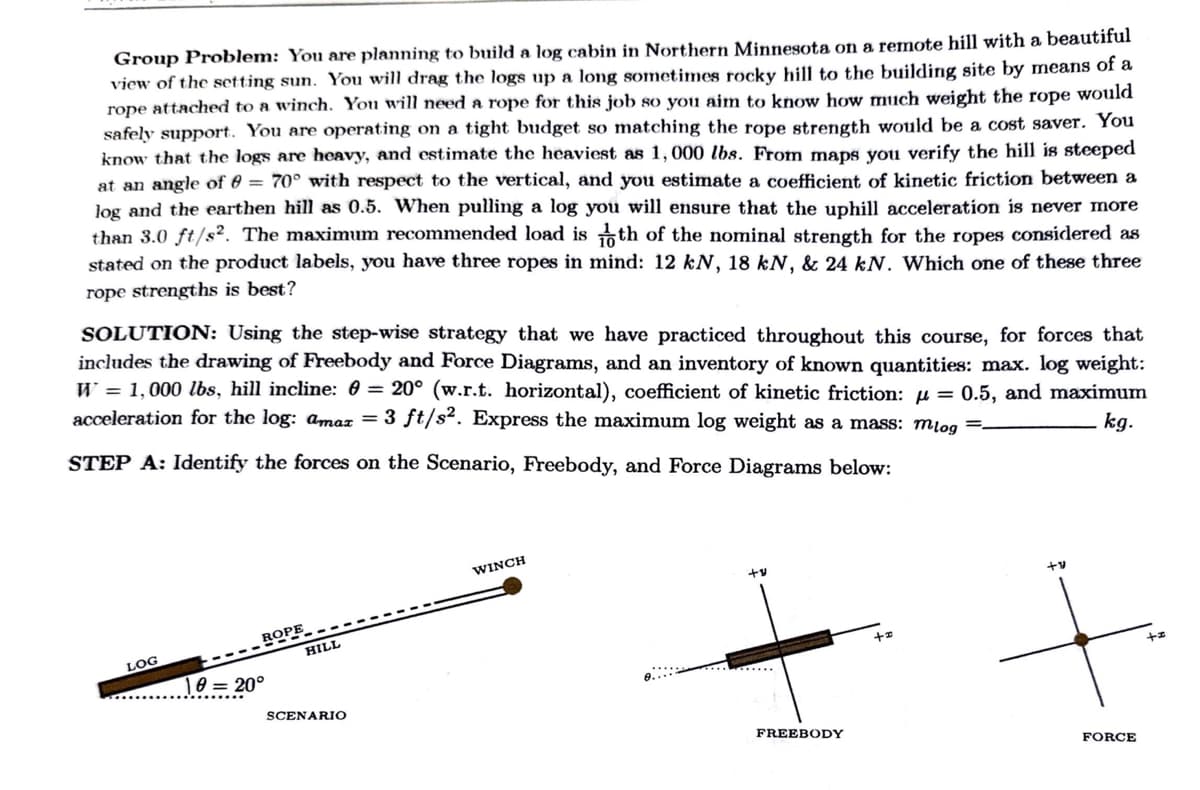Group Problem: You are planning to build a log cabin in Northern Minnesota on a remote hill with a beautiful view of the setting sun. You will drag the logs up a long sometimes rocky hill to the building site by means of a rope attached to a winch. You will need a rope for this job so you aim to know how much weight the rope would safely support. You are operating on a tight budget so matching the rope strength would be a cost saver. You know that the logs are heavy, and estimate the heaviest as 1,000 lbs. From maps you verify the hill is steeped at an angle of 8 = 70° with respect to the vertical, and you estimate a coefficient of kinetic friction between a log and the earthen hill as 0.5. When pulling a log you will ensure that the uphill acceleration is never more than 3.0 ft/s². The maximum recommended load is th of the nominal strength for the ropes considered as stated on the product labels, you have three ropes in mind: 12 kN, 18 kN, & 24 kN. Which one of these three rope strengths is best?
Group Problem: You are planning to build a log cabin in Northern Minnesota on a remote hill with a beautiful view of the setting sun. You will drag the logs up a long sometimes rocky hill to the building site by means of a rope attached to a winch. You will need a rope for this job so you aim to know how much weight the rope would safely support. You are operating on a tight budget so matching the rope strength would be a cost saver. You know that the logs are heavy, and estimate the heaviest as 1,000 lbs. From maps you verify the hill is steeped at an angle of 8 = 70° with respect to the vertical, and you estimate a coefficient of kinetic friction between a log and the earthen hill as 0.5. When pulling a log you will ensure that the uphill acceleration is never more than 3.0 ft/s². The maximum recommended load is th of the nominal strength for the ropes considered as stated on the product labels, you have three ropes in mind: 12 kN, 18 kN, & 24 kN. Which one of these three rope strengths is best?
Related questions
Question

Transcribed Image Text:Group Problem: You are planning to build a log cabin in Northern Minnesota on a remote hill with a beautiful
view of the setting sun. You will drag the logs up a long sometimes rocky hill to the building site by means of a
rope attached to a winch. You will need a rope for this job so you aim to know how much weight the rope would
safely support. You are operating on a tight budget so matching the rope strength would be a cost saver. You
know that the logs are heavy, and estimate the heaviest as 1,000 lbs. From maps you verify the hill is steeped
at an angle of 8 = 70° with respect to the vertical, and you estimate a coefficient of kinetic friction between a
log and the earthen hill as 0.5. When pulling a log you will ensure that the uphill acceleration is never more
than 3.0 ft/s². The maximum recommended load is th of the nominal strength for the ropes considered as
stated on the product labels, you have three ropes in mind: 12 kN, 18 kN, & 24 kN. Which one of these three
rope strengths is best?
SOLUTION: Using the step-wise strategy that we have practiced throughout this course, for forces that
includes the drawing of Freebody and Force Diagrams, and an inventory of known quantities: max. log weight:
W = 1,000 lbs, hill incline: 0= 20° (w.r.t. horizontal), coefficient of kinetic friction: = 0.5, and maximum
acceleration for the log: amax = 3 ft/s². Express the maximum log weight as a mass: mlog
kg.
STEP A: Identify the forces on the Scenario, Freebody, and Force Diagrams below:
LOG
ROPE
10 = 20°
HILL
SCENARIO
WINCH
+v
FREEBODY
+v
+
FORCE
21
Expert Solution
This question has been solved!
Explore an expertly crafted, step-by-step solution for a thorough understanding of key concepts.
Step by step
Solved in 2 steps with 1 images
